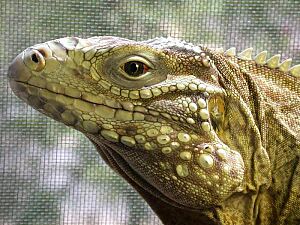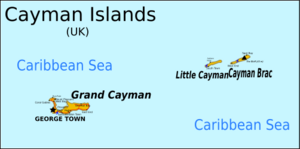Lesser Caymans iguana facts for kids
Quick facts for kids Cyclura nubila caymanensis |
|
|---|---|
 |
|
| Conservation status | |
| Scientific classification |
|
| Kingdom: | Animalia |
| Phylum: | Chordata |
| Class: | Reptilia |
| Order: | Squamata |
| Suborder: | Iguania |
| Family: | Iguanidae |
| Genus: | Cyclura |
| Species: | |
| Subspecies: |
C. n. caymanensis
|
| Trinomial name | |
| Cyclura nubila caymanensis (Barbour & G.K. Noble, 1916)
|
|
| Synonyms | |
|
|
The Cyclura nubila caymanensis, also known as the Lesser Caymans iguana, is a special type of iguana. It is a critically endangered subspecies of the Cuban iguana. This means it's a specific group within the Cuban iguana family that is in great danger of disappearing forever.
These iguanas live on two islands south of Cuba: Cayman Brac and Little Cayman. These islands are sometimes called the Sister Isles because they look similar and are close to each other. The number of these iguanas has gone down because of human development changing their habitat. Also, cats are a big threat, as they hunt and kill the iguanas. The population on Cayman Brac has been very small for many years.
Contents
About the Lesser Caymans Iguana
The Lesser Caymans iguana, Cyclura nubila caymanensis, is found only on Little Cayman and Cayman Brac. It is a subspecies of the Cuban iguana. This iguana has also been moved to Grand Cayman. There, it has mixed with the island's own blue iguana (C. lewisi).
The name nubila comes from a Latin word meaning 'cloudy' or 'gloomy'. The name caymanensis simply means 'from the Cayman Islands', where it lives.
This iguana can breed with the main Cuban iguana and also with the blue iguana. When they breed, their babies are healthy and can have their own babies too.
What They Look Like
The Lesser Caymans iguana is a medium to large lizard. It usually grows to be about 30 to 40 inches long. Like other Cyclura iguanas, males and females look different. This is called sexual dimorphism. Males are bigger than females.
Males also have bigger crests on their backs. They have larger pores on their thighs called femoral pores. These pores release special scents called pheromones to communicate.
Male iguanas can be light grey to green when they are grown up. Their heads are often light blue or reddish-pink. They have black bars on their bodies and tails, which fade as they get older. Females are usually duller in color, without the red or blue, but sometimes they have a greenish tint.
Young iguanas are light brown. They have five to ten lighter, V-shaped bands that are outlined in black. These bands break into spots on their sides. Adult iguanas, both male and female, have black front feet. One of these iguanas was recorded to have lived for 33 years!
Where They Live and Their Home
These iguanas are originally from Little Cayman and Cayman Brac. Some have been moved to Grand Cayman.
Like other Cyclura iguanas, the Lesser Caymans iguana needs good places to warm up in the sun. They also need areas to find food, lay their eggs, and hide from danger.
Scientists have used special tags and radio trackers to learn about these iguanas. In 2016, they found something surprising about where the iguanas prefer to live. People used to think they mostly lived in untouched dry scrubland inside the islands. But the research showed they spend more time in places changed by humans, like gardens and roadsides.
What They Eat and How They Reproduce
Like all Cyclura species, the Lesser Caymans iguana mainly eats plants. They munch on leaves, flowers, and fruits.
Mating happens in April or May, when the dry season is ending. Females usually lay 7 to 25 eggs in May or June. Because the soil inland is rocky, the females often have to travel to sandy coastal areas to build their nests. Many female iguanas gather in these nesting areas to lay their eggs. After laying, they spread out again. The baby iguanas hatch from their nests in early August to early September.
Protecting the Iguanas
Population and Status
The Lesser Caymans iguana is listed as critically endangered. This means it faces a very high risk of extinction in the wild. In 2012, experts believed there were only about 840 to 900 iguanas left on both islands. They also noted that the population was quickly getting smaller. Before this, in 1996, it was listed as vulnerable.
In 2012, a count on Cayman Brac found 86 iguanas. Sadly, one of them was killed by a car. More iguanas were seen but not tagged.
On Little Cayman, 120 nests were found in 2010. Later surveys in 2015 and 2016 found fewer nests. Over 900 iguanas were tagged on the island in 2015 and 2016. In 2015, the population was estimated at 2,915 iguanas. But by 2019, it dropped sharply to 1,786 iguanas. Scientists think this big drop is because of cats.
Threats to the Iguanas
In the mid-1990s, some scientists thought that losing their natural habitat was the biggest threat. This was because of new buildings and roads. However, as of 2020, habitat loss is not the main problem.
The biggest danger to these iguanas now is cats. Cats are killing many young iguanas. This means fewer young iguanas are growing up to become adults. Both wild cats and pets whose owners are not careful are a problem.
For a long time, people knew cats were a threat. In 1996, the Cayman Islands National Trust said that cats could be the "death knell" for the iguanas. They said a big effort was needed to reduce the thousands of wild cats. In 2018, the government tried to start a program to control the cat population. But two animal welfare groups stopped it with legal action. They argued that cat welfare was important and suggested neutering and vaccinating the cats instead of removing them. The government said this would not help the iguanas. Legal issues have made it hard for the government to control the wild cat population.
The only animal shelter on the islands is run by the Cayman Islands Humane Society. They help about 450 abandoned cats and dogs find new homes each year. Some wild cats are also caught and neutered.
Iguanas also like to warm up on black asphalt roads. This leads to some iguanas being hit by cars. In 2019, 44 iguanas were killed on roads. In 2020, up to November, 24 were killed.
In 2016, scientists found something new: the invasive green iguana (Iguana iguana) can breed with the Lesser Caymans iguana. Three hybrid baby iguanas were found on Little Cayman Island. These were the first clear hybrids between green iguanas and any Cyclura iguana found in the wild.
Breeding in Zoos
As early as 1992, Lesser Caymans iguanas were being kept in zoos and by private collectors. People who own these iguanas have started breeding programs. They breed purebred iguanas and sometimes mix them with blue iguanas or Cuban iguanas. This helps reduce the need to take iguanas from the wild for the pet trade.
In 2005, there wasn't a formal breeding program for this subspecies. But some thought it might be needed for the Cayman Brac population. Since the iguanas on Cayman Brac are genetically similar to those on Little Cayman, new genes could be brought in from the Little Cayman population if needed.




